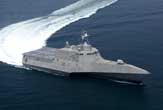To Stay Stable At Sea, Look to the Horizon

Looking into the distance has long been touted as a way to stay upright and free of seasickness despite the pitch and roll of a boat. Unlike some old wives' tales, horizon-gazing is good advice, according to a study published Jan. 26 in the journal Psychological Science. Staring at the horizon really does make people steadier while at sea.
The results could help researchers better understand the maddening phenomenon of motion sickness, said study author Thomas Stoffregen, a cognitive scientist at the University of Minnesota.
"It’s the people who become wobbly who subsequently become motion sick," Stoffregen said in a statement.
When standing on dry land, people sway back and forth by about 1.5 inches (4 centimeters) every 12 to 15 seconds. To find out how this changes on a ship, Stoffregen and his colleagues contacted the U.S. consortium that runs scientific research ships.
"I'm really an oddball for these folks, because they're studying oceanography, like hydrothermal vents. Here's this behavioral scientist, calling them up," Stoffregen said.
Stoffregen stays out of the oceanographers' way, boarding the ships between other projects. For the current study, he stayed on the research vessel Atlantis during a journey across the Gulf of California (between the Baja Peninsula and the Mexican mainland).
The researchers asked crew-member volunteers to stand on a force plate that would measure their movements, first on dry land in Mexico and then on the Atlantis. The crew members were told to look either at something about 16 inches (40 centimeters) in front of them or to focus on the horizon.
Get the world’s most fascinating discoveries delivered straight to your inbox.
Although it might seem that looking at something steady would make the ship's movement all the more noticeable, it helped to focus on a distant, steady point on the horizon while at sea, the researchers found. On land, people were more stable when looking at something close to them, but at sea, they stayed steadier while gazing far away.
Stoffregen suspects that the horizon provides a helpful point of reference, allowing people to sense the difference between their body's natural motion and the motion of the ship. He'd hoped to study gaze in relationship to seasickness, but none of his crew-member volunteers were afflicted. The best opportunity to capture maximum seasickness misery would be to catch a ride on a ship full of undergraduate oceanography majors on their first nautical voyage, Stoffregen said.
"I'd give my right arm to get on one of those," he said.
You can follow LiveScience Senior Writer Stephanie Pappas on Twitter @sipappas.

Stephanie Pappas is a contributing writer for Live Science, covering topics ranging from geoscience to archaeology to the human brain and behavior. She was previously a senior writer for Live Science but is now a freelancer based in Denver, Colorado, and regularly contributes to Scientific American and The Monitor, the monthly magazine of the American Psychological Association. Stephanie received a bachelor's degree in psychology from the University of South Carolina and a graduate certificate in science communication from the University of California, Santa Cruz.
